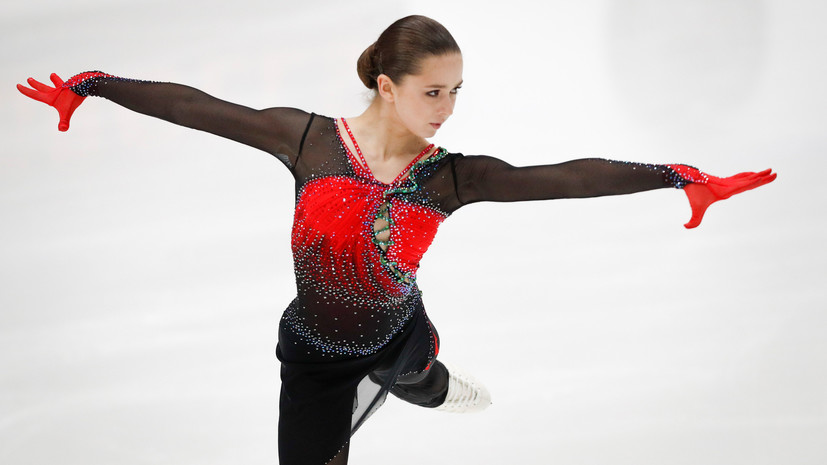The Finlandia Trophy tournament, which became the first serious test for several Russian skaters this season, ended on Sunday with women's free skating. Kamila Valieva, Alyona Kostornaya and Elizaveta Tuktamysheva had to compete for places on the podium and show what fans should expect in three weeks, when all three skaters will perform at the more crucial stage of the Grand Prix in Canada.
As a result of short programs, Tuktamysheva took the lead thanks to a perfectly executed triple axel, completed spins and quite generous components, because of which, other things being equal, she was usually inferior to competitors. But it was extremely difficult for the student of Alexei Mishin to defend the first place. If on the eve of all three Russian women had approximately equal technical content (except that Kostornaya at the last moment chose to lighten her axel), then they all announced completely different sets of elements for arbitrary rental.
The most difficult one was for Valieva. The 15-year-old figure skater was going to perform the triple axel at the international tournament on the second attempt, and at the same time add to it a quadruple salchow and two cascades with quadruple sheepskin coats. Already due to this, she could not worry about her lag by some 6.5 points from Tuktamysheva. The vice-world champion could answer with two triple axels and try to pull up the second mark again. Kostornaya in this internal Russian dispute was supposed to become an outsider - in her application there was only one triple axel, which she had not had for a long time at the official starts.
The program with three clean quadruple jumps has so far been performed only by Alexandra Trusova and Sofya Akatieva, and only the latter managed to add a triple axel to them.
Valieva already tried to demonstrate all these complex elements last season in the Russian Cup final, but then there were problems with all the quads.
Leaving the immortal Bolero as an accompaniment, the skater changed the arrangement of her jumps and started with a quadruple salchow.
Valieva performed it superbly, but then she could not reconfigure to the triple axel.
She again failed not only to land from it, but at least to tighten the jump in order to avoid even greater losses.
However, Valieva did not need to strain so much for the sake of the obstinate element. With cascades of wonderful quadruple sheepskin coats, she didn't care that there was such a shortage of points. The student Eteri Tutberidze completed all the quads with allowances for difficulty and at the same time retained the strength to demonstrate the highest level of skating. If on the eve of Valieva was unhappy with the rental because of the fall, this time she shone with happiness.
With this performance, Valieva immediately went down in history. For the free program, she received 174.31 points and surpassed the world record of Trusova, set for two years, by almost eight points. The highest achievement in the sum of two rentals, which belonged to Kostornaya, also fell. 249.24 points - this will now be the benchmark for girls in the Olympic season. The fans can only imagine with amazement how cosmic the numbers would be if it weren't for these annoying falls from the triple axel.
Kostornaya did not obey this element either.
She nevertheless tried to start her strong program to the accompaniment of Antonio Vivaldi's "Winter" with a once-branded jump, but made a spade with under-rotation.
Next, the European champion made a mistake on the triple lutz.
At some point, it might seem that she would have to fight for third place with her former compatriot Anastasia Gubanova, who now represents Georgia.
Kostornaya nevertheless gathered for the rest of the performance and brought it to the end, no longer giving cause for concern.
Although her marks for the free program were worse than those of the Belgian Luna Hendrix, the final 218.83 points still allowed the two Russian women to be side by side in the intermediate protocol.
As before, Tuktamysheva taught Tutberidze's students a lesson on how to perform a triple axel.
If it was still possible to find fault with the first attempt, combined with a double sheepskin coat, because of a slight under-rotation, then the solo jump turned out to be what it should be.
There could not be much doubt that Tuktamysheva would demonstrate her signature element.
It was much more interesting to see how the judges would react to the skater's return to her incendiary role, which usually did not cause them a great desire to load her with components.
By the end of the program, Tuktamysheva was getting worse and worse at maintaining concentration and gaining fourth levels of difficulty on choreographic elements, but even this was not a reason to lower her marks.
Student Mishina received the highest components in her career in the free program and again almost broke her personal records, as it was on Saturday.
Tuktamysheva scored 233.30 points and surpassed the winning result of Anna Shcherbakova at the World Championship.
With this performance, the 24-year-old figure skater significantly increased her chances in the fight for an Olympic ticket, which she has never gotten before.

